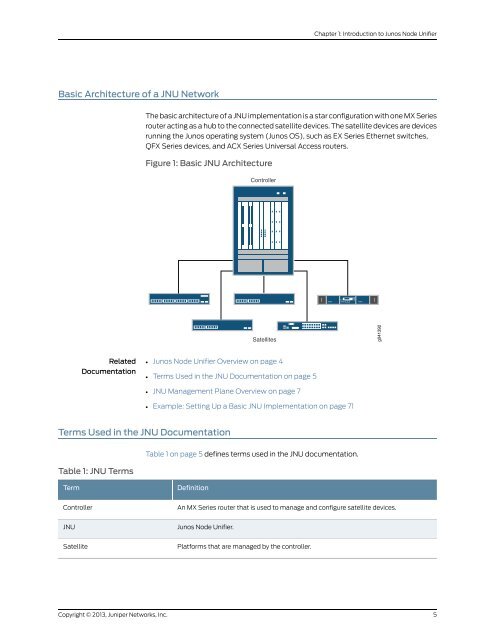Designing and Implementing a Junos Node Unifier Network
Designing and Implementing a Junos Node Unifier Network
Designing and Implementing a Junos Node Unifier Network
You also want an ePaper? Increase the reach of your titles
YUMPU automatically turns print PDFs into web optimized ePapers that Google loves.
Basic Architecture of a JNU <strong>Network</strong><br />
Related<br />
Documentation<br />
The basic architecture of a JNU implementation is a star configuration with one MX Series<br />
router acting as a hub to the connected satellite devices. The satellite devices are devices<br />
running the <strong>Junos</strong> operating system (<strong>Junos</strong> OS), such as EX Series Ethernet switches,<br />
QFX Series devices, <strong>and</strong> ACX Series Universal Access routers.<br />
Figure 1: Basic JNU Architecture<br />
•<br />
Controller<br />
Satellites<br />
<strong>Junos</strong> <strong>Node</strong> <strong>Unifier</strong> Overview on page 4<br />
• Terms Used in the JNU Documentation on page 5<br />
• JNU Management Plane Overview on page 7<br />
Terms Used in the JNU Documentation<br />
Table 1: JNU Terms<br />
Term<br />
Controller<br />
JNU<br />
Satellite<br />
Copyright © 2013, Juniper <strong>Network</strong>s, Inc.<br />
• Example: Setting Up a Basic JNU Implementation on page 71<br />
Table 1 on page 5 defines terms used in the JNU documentation.<br />
Definition<br />
An MX Series router that is used to manage <strong>and</strong> configure satellite devices.<br />
<strong>Junos</strong> <strong>Node</strong> <strong>Unifier</strong>.<br />
Platforms that are managed by the controller.<br />
Chapter 1: Introduction to <strong>Junos</strong> <strong>Node</strong> <strong>Unifier</strong><br />
g041392<br />
5
















